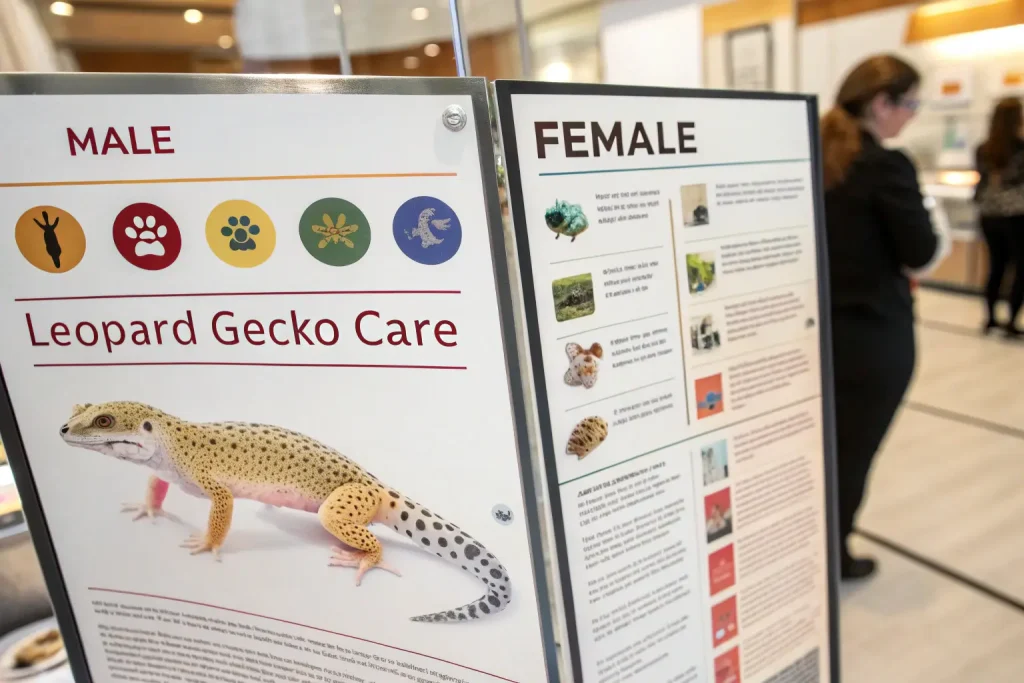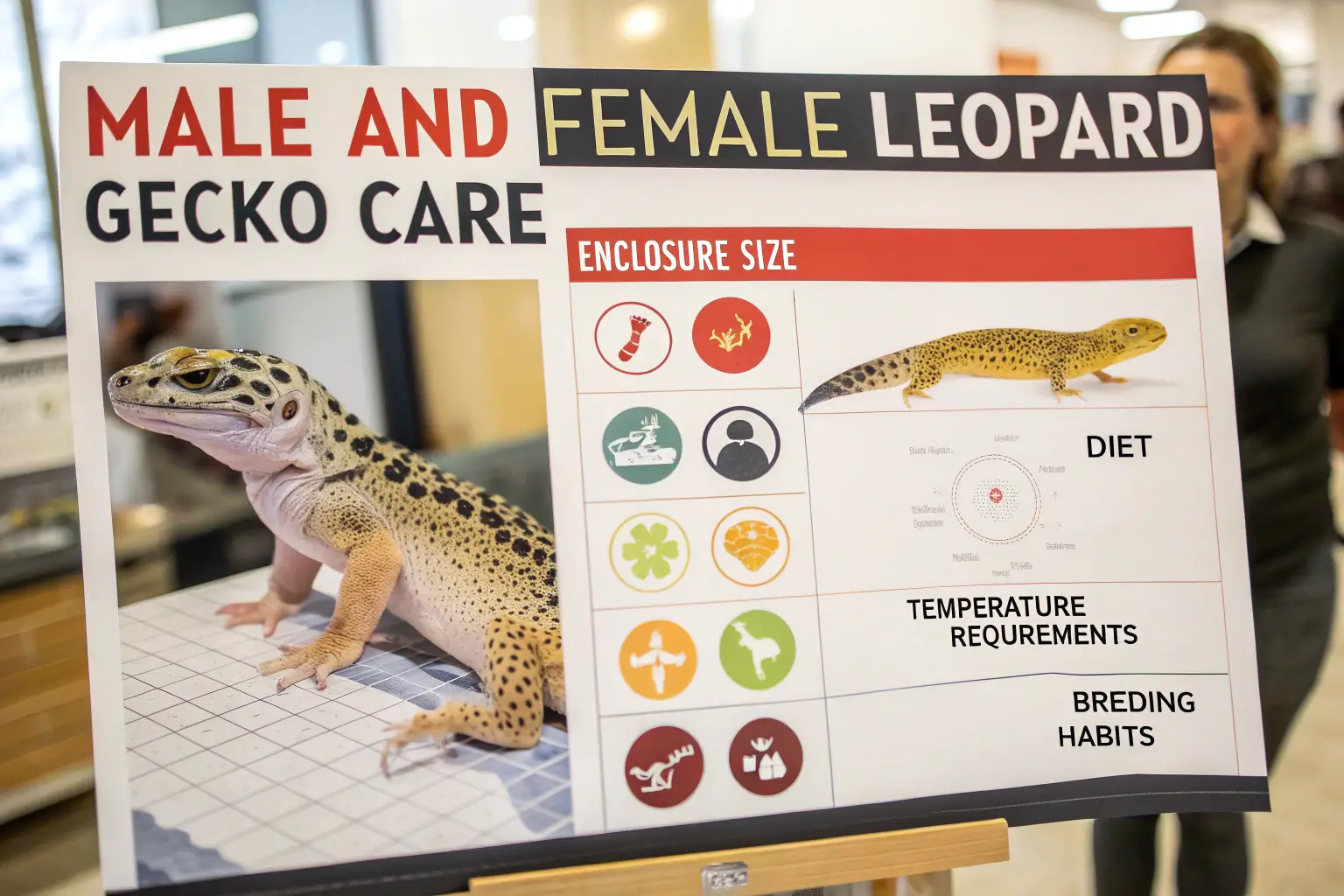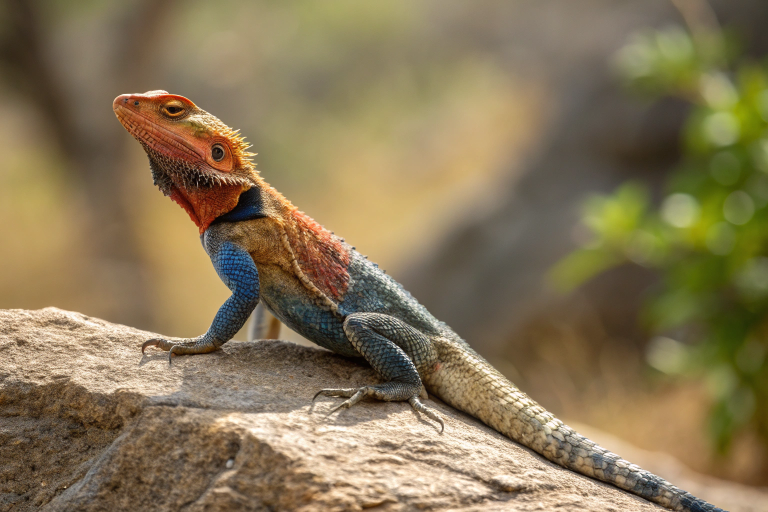9 Differences Between Male vs Female Leopard Gecko Care!
Are you trying to figure out whether to bring home a male or female leopard gecko? Perhaps you already have one but aren’t sure if you’re providing the right care based on their sex? Understanding the key differences between male vs female leopard gecko care can significantly impact your pet’s health and happiness.
As a long-time leopard gecko breeder and enthusiast, I’ve observed firsthand how these charming reptiles have distinct needs based on their gender. While they share many care requirements, the subtle differences in their biology, behavior, and health concerns matter tremendously for proper husbandry.
In this comprehensive guide, I’ll walk you through the nine critical differences between caring for male and female leopard geckos, backed by scientific research and years of hands-on experience. Whether you’re a first-time owner or looking to expand your reptile family, these insights will help you provide tailored care to your scaly friend.
Introduction
Leopard geckos (Eublepharidae) have become one of the most popular reptile pets worldwide, and for good reason. These charming creatures boast friendly dispositions, manageable sizes, and relatively straightforward care requirements compared to many exotic pets.
However, when it comes to providing optimal care for your leopard gecko, understanding sex-specific needs is crucial. Male vs female leopard gecko care differences might seem subtle at first glance, but they can significantly impact your pet’s health, behavior, and overall wellbeing in captivity.
Did you know that in the wild, male and female leopard geckos have evolved different behaviors and physical characteristics to fulfill their respective reproductive roles? These natural differences translate directly to captive care considerations that responsible owners should recognize.
Species Overview
Scientific Name: Eublepharis macularius
Leopard geckos belong to the family Eublepharidae and are one of the few gecko species with eyelids—a distinctive feature that gives them their characteristic “leopard-like” blinking expression that many owners find endearing.
Physical Characteristics
Both male and female leopard geckos typically grow to 8-10 inches in length and can live 15-20 years with proper care. They display beautiful spotted patterns on their skin, ranging from yellow and orange to lavender and white.
The most obvious physical difference between male vs female leopard gecko anatomy lies in their underside. Males develop distinct pre-anal pores (a V-shaped row of waxy dots) and hemipenal bulges at the base of the tail. Females lack these features and instead have smaller, less prominent pores and a narrower tail base.
Males tend to develop broader heads and thicker necks as they mature, while females often remain more slender. These dimorphic features typically become apparent around 6-8 months of age, making sexing juvenile geckos challenging.
Subspecies
While there are no officially recognized subspecies of Eublepharis macularius, the pet trade has developed numerous morphs with distinctive patterns and colorations through selective breeding. These include:
- High Yellow
- Tangerine
- Blizzard
- Albino varieties (Tremper, Bell, Rainwater)
- Carrot Tail
- Giant
These morphs don’t necessarily affect male vs female leopard gecko care differences, though some morphs may have specific genetic health considerations regardless of sex.
Habitat and Distribution
Natural Habitat
Leopard geckos are native to arid and semi-desert regions across Afghanistan, Pakistan, northwest India, and parts of Iran. They thrive in rocky terrains with minimal vegetation, where they can hunt invertebrates and find shelter from predators and extreme temperatures.
Geographic Range
In the wild, leopard geckos have adapted to harsh conditions with significant temperature fluctuations. Their native range experiences scorching daytime heat and considerably cooler nights—a pattern that should be mimicked in captivity regardless of your gecko’s sex.
Adaptations
Both male and female leopard geckos share remarkable adaptations:
- Fat-storing tails for energy reserves
- Eyelids that protect against sand and debris
- The ability to vocalize (rare among geckos)
- Specialized toe pads for navigating rocky terrain
However, when considering male vs female leopard gecko care, it’s worth noting that females have evolved to store additional calcium reserves for egg production—a physiological difference that impacts their nutritional requirements significantly.
Diet and Feeding Habits
What They Eat
Leopard geckos are insectivores, consuming a variety of arthropods in the wild. In captivity, their diet typically consists of:
- Crickets
- Dubia roaches
- Mealworms
- Superworms
- Hornworms (as occasional treats)
- Waxworms (sparingly, as they’re high in fat)
Hunting Behavior
Both sexes are crepuscular hunters, meaning they’re most active at dawn and dusk. Their hunting strategy involves stalking prey and pouncing with surprising speed and accuracy.

Dietary Needs: Male vs Female Leopard Gecko Differences
Female Dietary Requirements:
- Higher calcium demands, especially during breeding season
- More frequent calcium supplementation (2-3 times weekly)
- May require more protein when gravid (egg-bearing)
- Potentially need slightly smaller but more frequent meals
Male Dietary Requirements:
- Standard calcium supplementation (1-2 times weekly)
- Often consume slightly larger prey items
- May benefit from occasional fasting periods
- Typically require less frequent feeding as adults
These differences stem from the female’s biological role in producing eggs, which demands significant calcium resources. Without proper supplementation, breeding females are particularly susceptible to metabolic bone disease and calcium deficiency.
Behavior and Social Structure
Social Behavior
In their natural habitat, leopard geckos are primarily solitary creatures, coming together only for mating. This translates to captive care in important ways:
Male Social Considerations:
- Should never be housed with other males (territorial aggression)
- May be housed with females, but requires careful monitoring
- More likely to display territorial behaviors
- Often more active and exploratory
Female Social Considerations:
- Can sometimes cohabitate with other females (with sufficient space)
- Generally less territorial than males
- May become stressed by overly aggressive males
- Often more reserved in behavior
Communication
Leopard geckos communicate through a variety of methods including vocalizations, body postures, and tail movements. Males are typically more vocal, especially during breeding season, and may “bark” or chirp more frequently than females.
Mating and Reproduction
This represents one of the most significant areas of male vs female leopard gecko care differences:
Female Reproductive Considerations:
- Can lay eggs with or without male present (infertile if unfertilized)
- Need supplemental calcium to prevent egg-binding
- Require a dedicated laying box with moist substrate during breeding season
- May experience health issues related to egg production
- Can store sperm from one mating to produce multiple clutches
Male Reproductive Considerations:
- May become more aggressive and territorial during breeding season
- Typically don’t face the same health risks as breeding females
- Can breed with multiple females
- May need separation from females outside breeding season
Conservation Status
Endangerment Level
Leopard geckos are currently listed as Least Concern on the IUCN Red List. Their adaptability and fairly wide distribution have helped maintain stable populations in the wild.
Threats
While not endangered, wild leopard gecko populations face challenges from:
- Habitat loss due to agriculture and development
- Collection for the pet trade (though most pets are now captive-bred)
- Climate change affecting their arid habitats
Conservation Efforts
Most leopard geckos in the pet trade are captive-bred, reducing pressure on wild populations. Responsible breeding programs help maintain genetic diversity without impacting wild specimens.
Interesting Facts About Male vs Female Leopard Geckos
Temperature-Dependent Sex Determination: In some reptiles, including certain gecko species, incubation temperature can determine the sex of the offspring. While leopard geckos don’t exhibit this trait as strongly as some species, incubation temperatures can influence male/female ratios.
Tail Regeneration Differences: Both sexes can regenerate their tails if dropped, but males often regenerate slightly faster due to hormonal differences.
Longevity Variance: Female leopard geckos that regularly produce eggs throughout their lives may have slightly shorter lifespans (15-18 years) compared to males or non-breeding females (18-20+ years) due to the physical demands of egg production.
Calcium Storage: Females have specialized endolymphatic sacs that store calcium for egg production—these can sometimes be visible as white deposits behind their ears when they’re well-supplemented.
Behavioral Differences: Males typically establish and defend territories more aggressively, while females often prioritize finding secure hiding places and temperature gradients.
Tips for Caring for Male vs Female Leopard Gecko
Housing Considerations
For Males:
- Minimum 20-gallon tank for a single male
- Multiple hides on both warm and cool sides
- Territorial visual barriers if housed near other males
- Deeper substrate for digging and exploration
For Females:
- Similar basic setup to males
- Additional moist hide if breeding is possible
- Laying box with 4-6 inches of moist substrate during breeding season
- Slightly higher humidity may benefit egg-laying females
Health Considerations
Female-Specific Health Issues:
- Egg binding (dystocia)
- Calcium deficiency during egg production
- Prolapse during egg-laying
- Reproductive system infections
- Follicular stasis (infertile egg retention)
Male-Specific Health Issues:
- Hemipenal impaction or prolapse
- Territorial stress if housed improperly
- Aggressive behaviors requiring medical attention
- Sebaceous gland overactivity
Regular veterinary check-ups are important for both sexes, but breeding females should be monitored especially closely for signs of calcium deficiency or egg-binding, which can be life-threatening conditions.
Role in the Ecosystem
Ecological Importance
In their natural habitat, leopard geckos serve as both predators and prey, helping to control insect populations while providing food for larger predators like snakes and birds of prey.
Gender-Specific Ecosystem Roles
While both sexes contribute to population maintenance, females play the critical role of producing eggs and ensuring genetic diversity. Males compete for mating opportunities, allowing for natural selection of the strongest genetic traits.
In captivity, understanding these natural roles helps us provide more appropriate care based on sex-specific behaviors and needs.
Conclusion
The differences between male vs female leopard gecko care might seem subtle in some areas and significant in others, but they all contribute to providing the best possible life for your reptilian companion. Whether you’re deciding which sex to bring home or ensuring your current pet receives optimal care, recognizing these distinctions matters.
Remember that individual personality variations exist within both sexes—some females may be bolder than average, while some males might be exceptionally docile. Always observe your specific gecko’s behavior and adjust care accordingly.
By honoring the natural biological differences between male and female leopard geckos, you’re not only providing better care but also deepening your understanding of these fascinating creatures. Your attention to these details will reward you with a healthier, happier gecko that may well be part of your life for two decades or more.
Frequently Asked Questions
How can I tell if my leopard gecko is male or female?
Look for hemipenal bulges (two bumps) at the base of the tail and a V-shaped row of pre-anal pores—these indicate a male. Females lack these bulges and have minimal or no visible pores. This becomes easier to identify as they reach 6-8 months of age.
Do male leopard geckos grow larger than females?
On average, males may develop slightly broader heads and thicker necks, but the overall length difference is minimal. Both typically reach 8-10 inches, with some giant morphs growing larger regardless of sex.
Are male or female leopard geckos better pets for beginners?
Both make excellent pets for beginners. Males may be slightly more active and entertaining to watch, while females tend to be less territorial. If you want to avoid potential egg-laying health concerns, males might be marginally easier.
Can male and female leopard geckos live together?
Yes, but with caution. One male can live with several females if the enclosure is large enough (40+ gallons), but be prepared for breeding behavior and potential stress on females. Never house multiple males together, as they will fight.
Do female leopard geckos need special care during egg-laying season?
Absolutely. Breeding females need extra calcium supplementation, a dedicated laying box with moist substrate, and close monitoring for signs of egg binding or calcium deficiency. Even unbred females may produce infertile eggs requiring similar care.
How often should I feed male vs female leopard geckos?
Adult males typically do well with feeding every 2-3 days, while breeding females might benefit from smaller, more frequent meals (every 1-2 days) with extra calcium supplementation. Adjust based on body condition and activity level.
Are female leopard geckos more docile than males?
Individual personality varies more than sex-based temperament, but males can become more territorial, especially during breeding season. Well-socialized geckos of either sex can be equally handleable and friendly.
Do males or females have more health problems?
Breeding females face more potential health issues related to egg production (calcium deficiency, egg binding), while males may experience hemipenal problems. Non-breeding females generally have similar health profiles to males.
Should I choose a male or female if I want just one leopard gecko?
Either sex makes an excellent solitary pet. Choose based on personality rather than gender if possible. If you’re concerned about potential egg-laying issues, a male might be slightly less maintenance in the long run.







